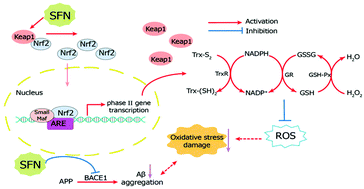Sulforaphane (SFN), a potent nuclear factor erythroid 2-related factor 2 (Nrf2) activator, presents a potential role in improving Alzheimer's disease (AD)-specific symptoms. However, the regulation mechanism of SFN in AD is poorly understood. Here, we established AD models both in vitro and in vivo. Animal behaviors were tested by the Morris water maze test. The pathology of the hippocampus and the content of Aβ were detected. SFN (40 mg kg−1) decreased the escape latency (24.96 ± 7.43 s) and increased the target-zone frequency (3.19 ± 1.19) in rats. SFN improved the pathological morphology and the number of neurons in the hippocampus. Additionally, SFN significantly upregulated the contents of thioredoxin and glutathione as well as the activities of antioxidant enzymes, along with the expression of the Nrf2 protein. Conversely, SFN lowered the Aβ content and ROS level in N2a/APP cells. After silencing the Nrf2 by SiRNA, the inhibitory effects of SFN on ROS and Aβ production were partially weakened. In conclusion, the improvement of AD by SFN was closely related with Nrf2 activation.

